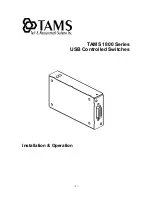
1. Functional Overview > Serial RapidIO Interface
26
Tsi578 User Manual
June 6, 2016
Integrated Device Technology
www.idt.com
1.2
Serial RapidIO Interface
The Tsi578 provides high-performance serial RapidIO interfaces that are used to provide connectivity
for control plane and data plane applications. All RapidIO interfaces are compliant with the
RapidIO
Interconnect Specification (Revision 1.3)
.
This section describes the transport layer features common to all Tsi578 RapidIO interfaces. The
RapidIO interface has the following capabilities:
•
RapidIO packet and control symbol transmission
•
RapidIO packet and control symbol reception
•
Register access through RapidIO maintenance requests
1.2.1
Features
The following features are supported:
•
Up to eight 4x-mode or up to 16 1x-mode serial RapidIO ports operating at up to 3.125 Gbits/s
•
Per-port destination ID look-up table, used to direct packets through the switch
•
RapidIO error management extensions, including both hardware and software error recovery
(described in
RapidIO Interconnect Specification (Revision 1.3)
Part 8)
•
Low latency forwarding of the multicast control symbol
•
Proprietary registers for performance monitoring and tuning
•
Both cut-through and store-and-forward modes for performance tuning
•
Debug packet generation and capture
•
Multicast functionality (described in
RapidIO Interconnect Specification (Revision 1.3) Part 11)
•
Head-of-line blocking avoidance
1.2.2
Transaction Flow Overview
Packets and control symbols are received by the Serial RapidIO Electrical Interface (Serial MAC) and
forwarded to the RapidIO Interface (for more information on the Serial MAC, refer to
Electrical Interface” on page 65
). Received packets have their integrity verified by error checking.
Once the packet’s integrity has been verified, the destination ID of the packet is used to access the
routing lookup table to determine which port the packet should be forwarded to and whether the packet
is a multicast packet. The packet is then buffered by the Internal Switch Fabric (ISF) for transmission
to the port. After the packet is transferred to the egress port, the port transmits the packet. If a packet
fails the CRC check, the packet is discarded and the transmitter is instructed to retransmit the packet
through the use of control symbols.
The egress port receives packets to be transmitted from the ISF. The integrity of packets forwarded
through the ISF is retained by sending the CRC code received with the packet. For more information
on the input and ouput queues, refer to
.
This is a IDT-specific implementation. The
RapidIO Interconnect Specification (Revision 1.3)
standard implementation of look-up tables is also supported.
















































